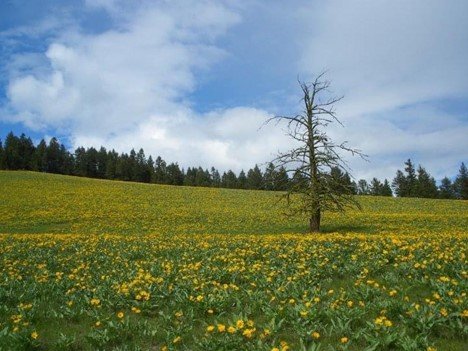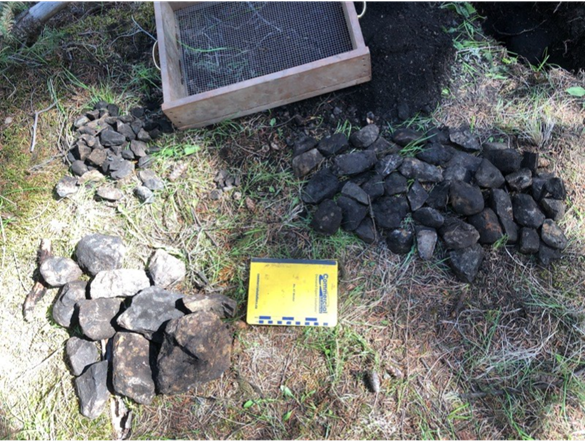Last summer, before the Sparks Lake wildfire, we were shovel testing a forestry block east of the Deadman River, approximately eight kilometers northwest of Kamloops Lake. We excavated part of a feature that was likely used as an earth oven, also referred to as a pit oven or roasting pit. Earth ovens are one of the oldest food preparation technologies used globally. Evidence of earth ovens has been found in Southern France, Japan, Australia, and Papua New Guinea, from sites as old as 30,000 years. Ancient pit-cooking features have also been found in Polynesia, Mexico, and throughout many parts of North America. In western North America and in the Kamloops area specifically, archaeological evidence respectively dates back to at least 12,000 and 7,000 years ago.
In the archaeological record, earth ovens are one type of cultural depression in which abundant fire-altered rocks and charcoal are present. Sometimes charred plant and animal remains are also recovered. Although there were variations in ancient pit-cooking technologies, they all have commonalities in their manufacture and use. The process generally consisted of: 1) digging or re-digging a pit ranging in size from one meter to larger than seven meters, 2) collecting fuel, rocks and vegetation, 3) harvesting and preparing the foods, 4) and cooking, which would take a few hours up to several days. Usually, the earth ovens were capped with earth, and sometimes a fire was built on top. Other variations include lining the pit with flat rocks, and/or adding water through a hole to create steam.
In the Kamloops area, the primary use of earth ovens was for processing root vegetables, however other foods such as fish, game, and berries were also cooked or used as flavourings. Root vegetables (including bulbs, corms, tubers, rhizomes and true roots) were a big part of Secwépemc diet, comprising anywhere from 30 to 60 percent of people’s caloric intake. Some local examples of traditional root-digging areas include Lac du Bois, Scheidam Flats, Hat Creek and Botanie Valley.
Many edible bulbs and tubers contain a complex carbohydrate called inulin. Inulin is a prebiotic that supports the growth of healthy intestinal bacteria and reduces the risk of chronic diseases. However, inulin is difficult to digest and requires pit-cooking to break down the starch into fructose, a sweet-tasting digestible sugar. Important root vegetables that contain inulin in this area include tséts’elq (balsamroot), qwléwe (nodding onion), qéq̓me (chocolate lily or rice root), qweq̓wíle (desert parsley or biscuit-root), and scwicw (glacier lily).
In this region, earth ovens are often found in two contexts: either associated with village sites, or upland near root-digging grounds. Analysis of archaeobotanical remains from earth ovens in these two contexts has shown that village earth ovens were used to cook a greater variety of foods and used more often than those located in the uplands, where their main function was root processing. Interestingly, between 3,300 and 2,400 years ago, the use of earth ovens in the uplands increased, which shows how these archaeological features can reveal information about changing subsistence strategies.
Charcoal analysis has shown that hot-burning trees were preferred for fuel, such as cottonwood, Douglas-fir, and pine. Remnants of matting recovered from earth ovens also shows that plants such as horsetails, raspberry and conifer branches, as well as grasses were used during the cooking process. This green vegetation created steam during the cooking process and helped protect the food, which is one reason root foods are difficult to find in the archaeobotanical record: well-cooked roots protected from charring were completely consumed. Also, when charred they tend to fragment into indistinguishable pieces.
Root vegetables are no longer a staple food of the Secwépemc diet, however many roots are still harvested and used medicinally. Roots also continue to be part of the spiritual world and are actors in stories that have been passed down for thousands of years. Sadly, root plants are not as plentiful as they were in the past due to several factors such as the discontinuation of Indigenous management strategies, overgrazing by cattle, and the spread of invasive species as a result of colonization. Several First Nations in B.C. continue to use pit-cooking, known in Secwepemctsin as tsq̓elstém, for special occasions and educational purposes. By researching ancient food processing techniques like pit-cooking, archaeologists attain a better understanding of past subsistence strategies and help support the cultural continuity of these practices. It is also important to support Indigenous management strategies to ensure these plants will continue to grow.



